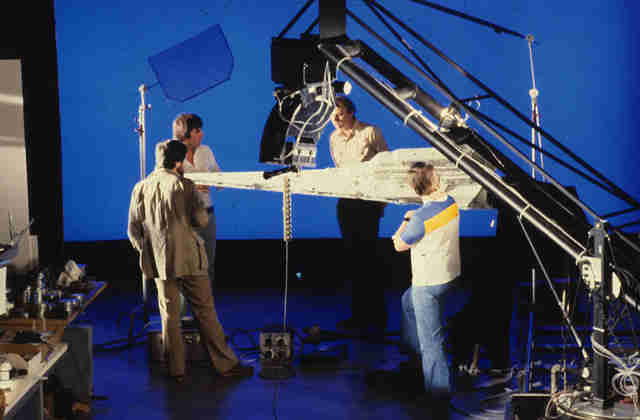
Before Star Wars, sci-fi movies depicted spacecraft as huge and slow, and alien worlds were depicted as clean and slick. Star Wars changed the way people viewed sci-fi movies, with fast and exhilarating spaceships that resembled F16s dogfighting in space (in fact, George Lucas used dogfight footage from WW2, and just replaced the Spitfires with X-wings) . New technology designed specifically for Star Wars was used to get the desired effect of speed and movement: the Dykstraflex camera. Designed by Star Wars visual effects supervisor John Dykstra, was a computer controlled camera that would move around a stationary spaceship in front of a blue backdrop, giving the visual effect that the spaceship was the one moving. This allowed dynamic scenes to be created, with several shots layered on top of each other, for the computer- controlled camera could film different objects from the exact same angle: this is how greenscreen shots work today, and the smooth movable camera technique is the basis for filming movies of all types today. The Dykstraflex also allowed dynamic stop motion shots to create the infamous AT-AT walkers and the Tauntauns in The Empire Strikes Back.

Industrial Light and Magic, the special effects studios for Star Wars, was the master of oil matte painting, the precursor to creating CGI backgrounds, making it look like the scenes of Star Wars were filmed in anther world while they were really filmed in the studio’s parking lot. The paintings were made on plexiglass, leaving some space blank so that the actors could be placed on the scene: the paintings were so realistic, it would be hard to spot the difference between the “real” world and the painted one. Most of the worlds in the original Star Wards trilogy were hand-painted: nowadays, CGI replaces matte painting.


Overall, the ILM special effects team paved the way for how the the effects pipeline works today. Every subsequent Star Wars movies made the special effects of the previous obsolete, driving the sci-fi and movie industry to new horizons with every installment.
Sources:
https://www.thrillist.com/entertainment/nation/star-wars-behind-the-scenes-history-ilm-industrial-light-magic-making-special-effects
https://gizmodo.com/the-amazing-matte-paintings-from-star-wars-and-their-cr-1680372651

Industrial Light and Magic, the special effects studios for Star Wars, was the master of oil matte painting, the precursor to creating CGI backgrounds, making it look like the scenes of Star Wars were filmed in anther world while they were really filmed in the studio’s parking lot. The paintings were made on plexiglass, leaving some space blank so that the actors could be placed on the scene: the paintings were so realistic, it would be hard to spot the difference between the “real” world and the painted one. Most of the worlds in the original Star Wards trilogy were hand-painted: nowadays, CGI replaces matte painting.


Overall, the ILM special effects team paved the way for how the the effects pipeline works today. Every subsequent Star Wars movies made the special effects of the previous obsolete, driving the sci-fi and movie industry to new horizons with every installment.
Sources:
https://www.thrillist.com/entertainment/nation/star-wars-behind-the-scenes-history-ilm-industrial-light-magic-making-special-effects
https://gizmodo.com/the-amazing-matte-paintings-from-star-wars-and-their-cr-1680372651
I found it very interesting that Star Wars was not only massively influential in pop culture, but also influential in special effect. You mentioned CGI and I assumed it was invented sometime in the 70s or 80s but after doing some research, its first use in a movie was in 1958 in Alfred Hitchcock's Vertigo. CGI only became mainstream in the 80s because it had developed practical uses which matched the movie industries standards.
ReplyDeleteHere is a link to Hitchcock's CGI in Vertigo
https://www.youtube.com/watch?v=GQwp6M2q1NE
Source:
https://nofilmschool.com/History-of-CGI